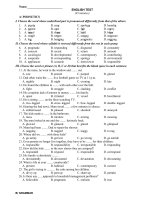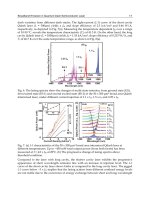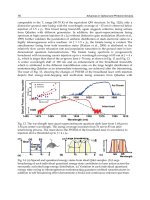Selverstone optical min 2
Bạn đang xem bản rút gọn của tài liệu. Xem và tải ngay bản đầy đủ của tài liệu tại đây (1.09 MB, 29 trang )
Optical Mineralogy in a Nutshell
Use of the petrographic microscope
in three easy lessons
Part II
© 2003 Prof. Jane Selverstone
Used and modified with permission
Quick review
•
Isotropic minerals –velocity changes as light enters
mineral, but then is the same in all directions thru xtl;
no rotation or splitting of light.
These minerals are characterized by a single RI
(because light travels w/ same speed throughout xtl)
• Anisotropic minerals –light entering xtls is split and
reoriented into two plane-polarized components that
vibrate perpendicular to one another and travel w/
different speeds.
•
Uniaxial minerals have one special direction along which light
is not reoriented; characterized by 2 RIs.
•
Biaxial minerals have two special directions along which light
is not reoriented; characterized by 3 RIs.
Determining if mineral is uniaxial or biaxial
or
Uniaxial
If Uniaxial, isogyres define a
cross; arms remain N-S/E-W as
stage is rotated
Biaxial
If Biaxial, isogyres define a curve that
rotates with stage, or cross that
breaks up as stage is rotated
Reminder about how to get an interference figure
1. Find a grain that stays dark as stage is rotated
2. Go to highest power objective
3. Swing the condenser in and open the diaphragm iris
4. Insert the Bertrand Lens (if present) or remove the
eyepiece.
5. Look down the scope and then rotate stage
Determining optic sign
Now determine the optic sign of the mineral:
1. Rotate stage until isogyre is concave to NE (if biaxial)
2. Insert gypsum accessory plate
3. Note color in NE, immediately adjacent to isogyre -
Blue = (+)
Yellow = (-)
Uniaxial
Biaxial
(+)
(-)
We’ve talked about minerals splitting light here’s what it looks like.
calcite
ca
te
lci
c al
calcite
cite
calcite
ordinary
ray, ω
(stays stationary)
extraordinary
ray, ε
(rotates)
Conclusions from calcite experiment
• single light ray coming into cc is split into two
• ε ray is refracted - changes direction & speed
• rays have different velocities, hence different RIs
• stationary ray=ordinary, rotating ray=extraordinary
• because refraction of ε is so large, Calcite must have hi
δ
(remember: δ = nhi - nlo)
If we were to look straight down c-axis, we would see
only one dot – no splitting!
The c-axis is the optic axis for Calcite
(true for all Uniaxial minerals, but unfortunately not for Biaxial minerals)
Birefringence/interference colors
Thickness in microns
birefringence
Retardation in nanometers
Back to birefringence/interference colors
∆=retardation
fast ray
(low n)
slow ray
(high n)
d
mineral
grain
plane polarized
light
lower polarizer
Observation: frequency of
light remains unchanged
during splitting, regardless of
material
F= V/λ
if light speed changes,
λ must also change
∀λ is related to color; if λ changes,
color changes
• waves from the two rays can be in
phase or out of phase upon leaving
the crystal
Interference phenomena
• When waves are in phase, all light gets killed
• When waves are out of phase, some component of light
gets through upper polarizer and the grain displays an
interference color; color depends on retardation
• When one of the vibration directions is parallel to the
lower polarizer, no
light gets through
the upper polarizer and
the grain is “at
extinction” (=black)
At time t, when slow ray 1st exits xtl:
Slow ray has traveled distance d
Fast ray has traveled distance d+∆
∆=retardation
fast ray
(low n)
slow ray
(high n)
d
time = distance/rate
Slow ray:
t = d/Vslow
Fast ray:
t= d/Vfast + ∆/Vair
Therefore: d/Vslow = d/Vfast + ∆/Vair
mineral
grain
∆ = d(Vair/Vslow - Vair/Vfast)
plane polarized
light
lower polarizer
∆ = d(nslow - nfast)
∆=dδ
∆ = thickness of t.s. x birefringence
Determining optic sign with the gypsum plate - what happens?
blue in NE = (+)
Gypsum plate has constant ∆ of
530 nm = 1st-order pink
slo
w
Isogyres = black:
∆=0
Background = gray: ∆=150
Add to/subtract from 530 nm:
530+150=680 nm = blue = (+)
530-150=380 nm = yellowish = (-)
Addition = slow + slow
Subtraction = slow + fast
Let’s look at interference colors in a natural thin section:
plag
ol
ol
plag
ol
plag
plag
plag
ol
ol
ol
plag
Note that different grains of the same mineral show
different interference colors – why?
Different grains of same mineral are in different orientations
Time for another concept: the optical indicatrix
Thought experiment:
Consider an isotropic mineral (e.g., garnet)
Imagine point source of
light at garnet center;
turn light on for fixed
amount of time, then map
out distance traveled by
light in that time
What geometric shape is defined by mapped light rays?
Isotropic indicatrix
Soccer ball
(or an orange)
Light travels the same
distance in all directions;
n is same everywhere,
thus δ = nhi-nlo = 0 = black
anisotropic minerals - uniaxial
indicatrix
c-axis
c-axis
calcite
quartz
Let’s perform the same thought experiment…
Uniaxial indicatrix
c-axis
Spaghetti squash = Uniaxial (+)
quartz
c-axis
tangerine = Uniaxial (-)
calcite
The shapes reflect the relative sizes of indices of refraction
Uniaxial indicatrix
nω
nε
nω
nω
Circular section is perpendicular to the stem (c-axis)
Uniaxial Indicatrix
c=Z
c=Z
nε
nω
b=Y
nε
a=X
b=Y
nω
a=X
Uniaxial (-)
Uniaxial (+)
What can the indicatrix tell us about
optical properties of individual grains?
Propagate light along the c-axis,
note what happens to it in plane of
thin section
c=Z
nε
nω
b=Y
a=X
nω
nω
nω - nω = 0
therefore, δ=0: grain stays black
(same as the isotropic case)
Now propagate light perpendicular to c-axis
N
nε - nω > 0
therefore, δ > 0
ω
nnε ε
n ωnω
W
nnω
nω
n
nε
nε
ε
E
S
Grain changes color upon rotation.
Grain will go black whenever indicatrix
axis is E-W or N-S
This orientation will show the maximum δ of the mineral
anisotropic minerals - biaxial indicatrix
clinopyroxene
feldspar
Now things get a lot more complicated…
Biaxial indicatrix
(triaxial ellipsoid)
OA
Z
2Vz
OA
2Vz
nγ
Y
nβ
nβ
nα
nβ
The potato!
X
nγ
nγ
nα
nβ
nα
nβ
There are 2 different ways to cut this and get a circle…
Alas, the potato (indicatrix) can have any orientation
within a biaxial mineral…
Y c
a
Z
Z
olivine
c
augite
(cpx)
b
Y
b
X
a
X
… but there are a few generalizations that we can make
The potato has 3 perpendicular principal axes of
different length – thus, we need 3 different RIs
to describe a biaxial mineral
X direction = nα (lowest)
Y direction = nβ (intermed; radius of circ. section)
Z direction = nγ (highest)
• Orthorhombic: axes of indicatrix coincide w/ xtl axes
• Monoclinic: Y axis coincides w/ one xtl axis
• Triclinic: none of the indicatrix axes coincide w/ xtl axes
2V: a diagnostic property of biaxial minerals
OA
Z
OA
• When 2V is acute about Z: (+)
2Vz
• When 2V is acute about X: (-)
• When 2V=90°, sign is indeterminate
nγ
• When 2V=0°, mineral is uniaxial
Y
nβ
nα
X
2V is measured using an interference figure…
More in a few minutes









